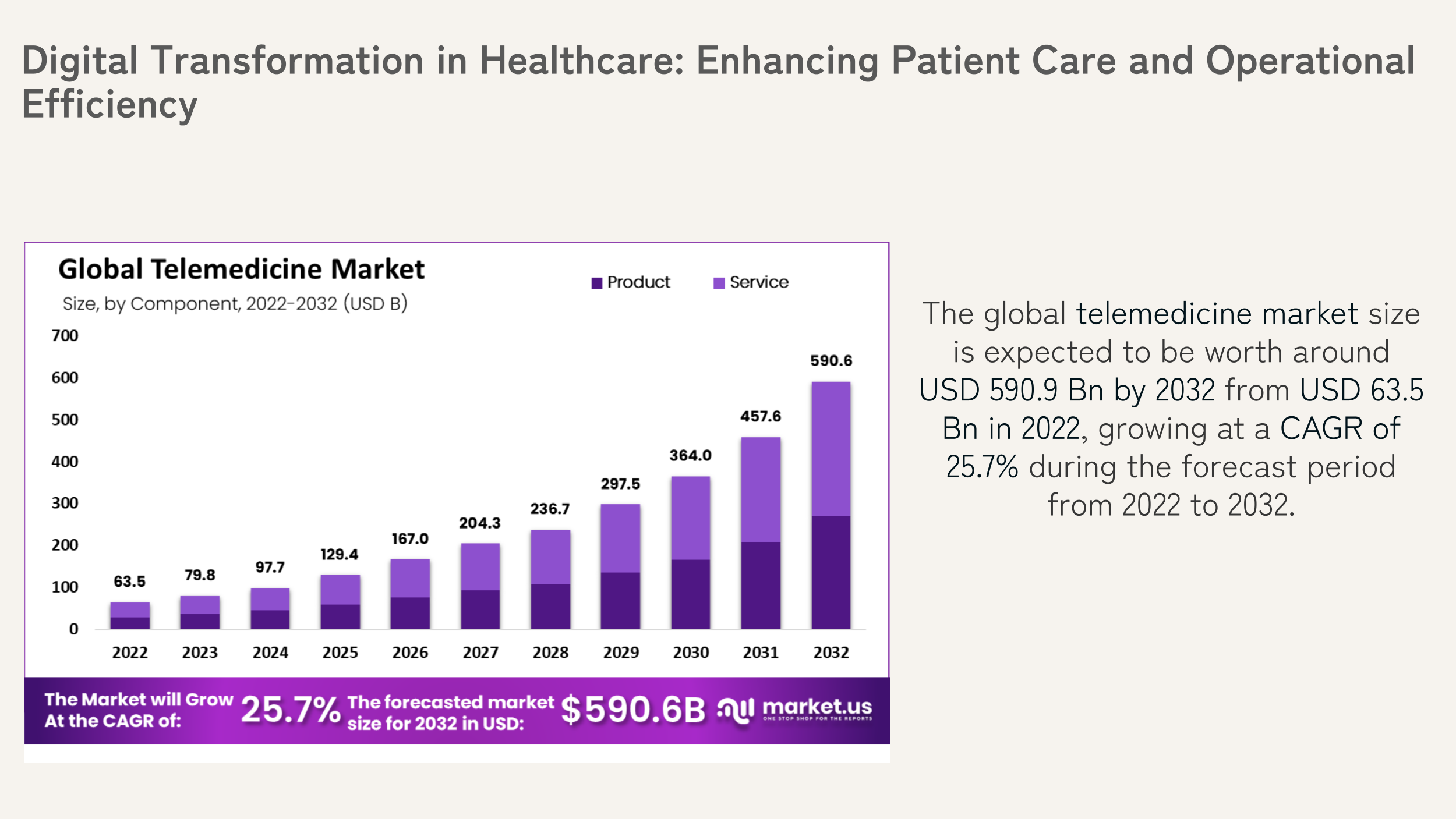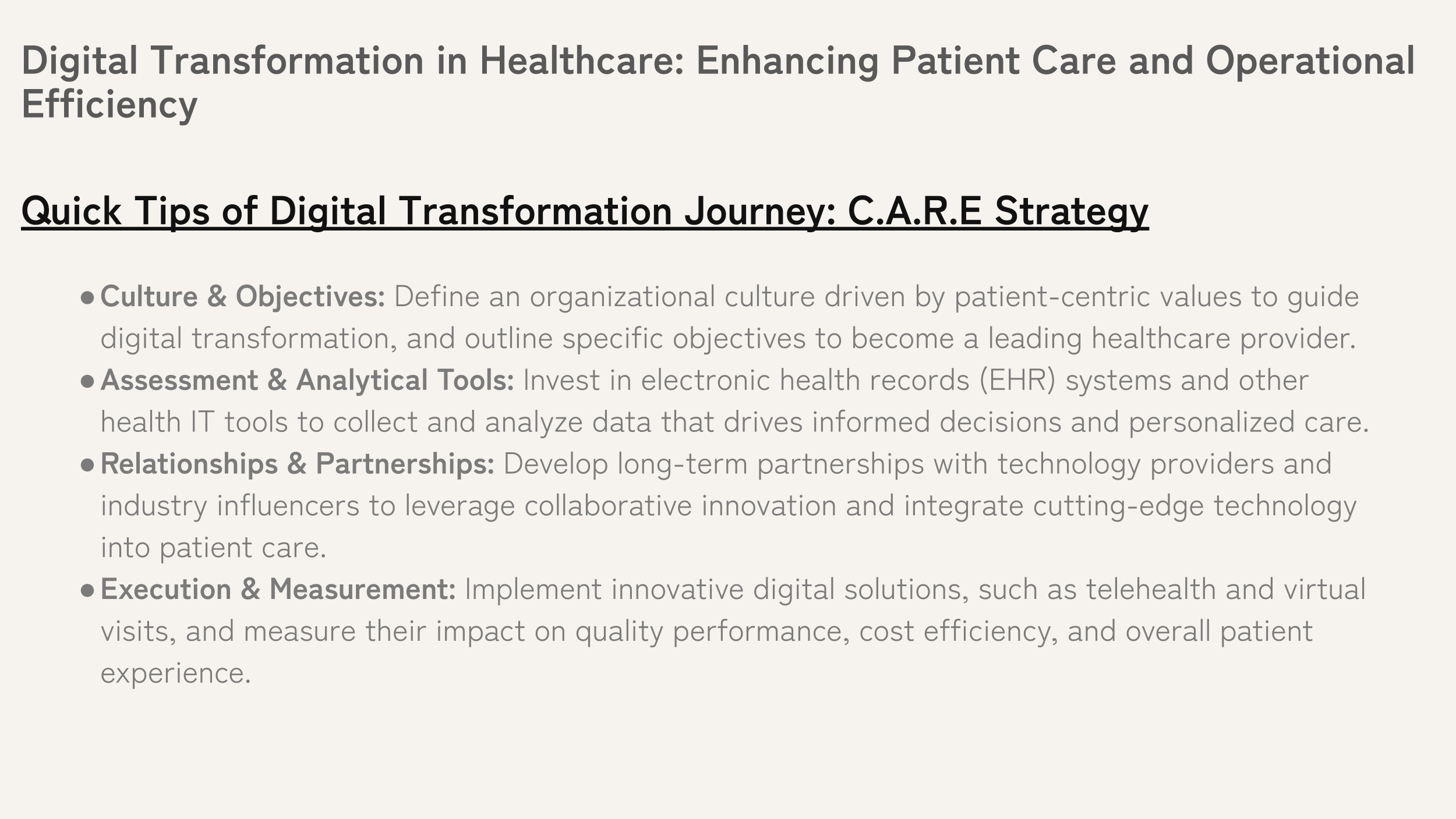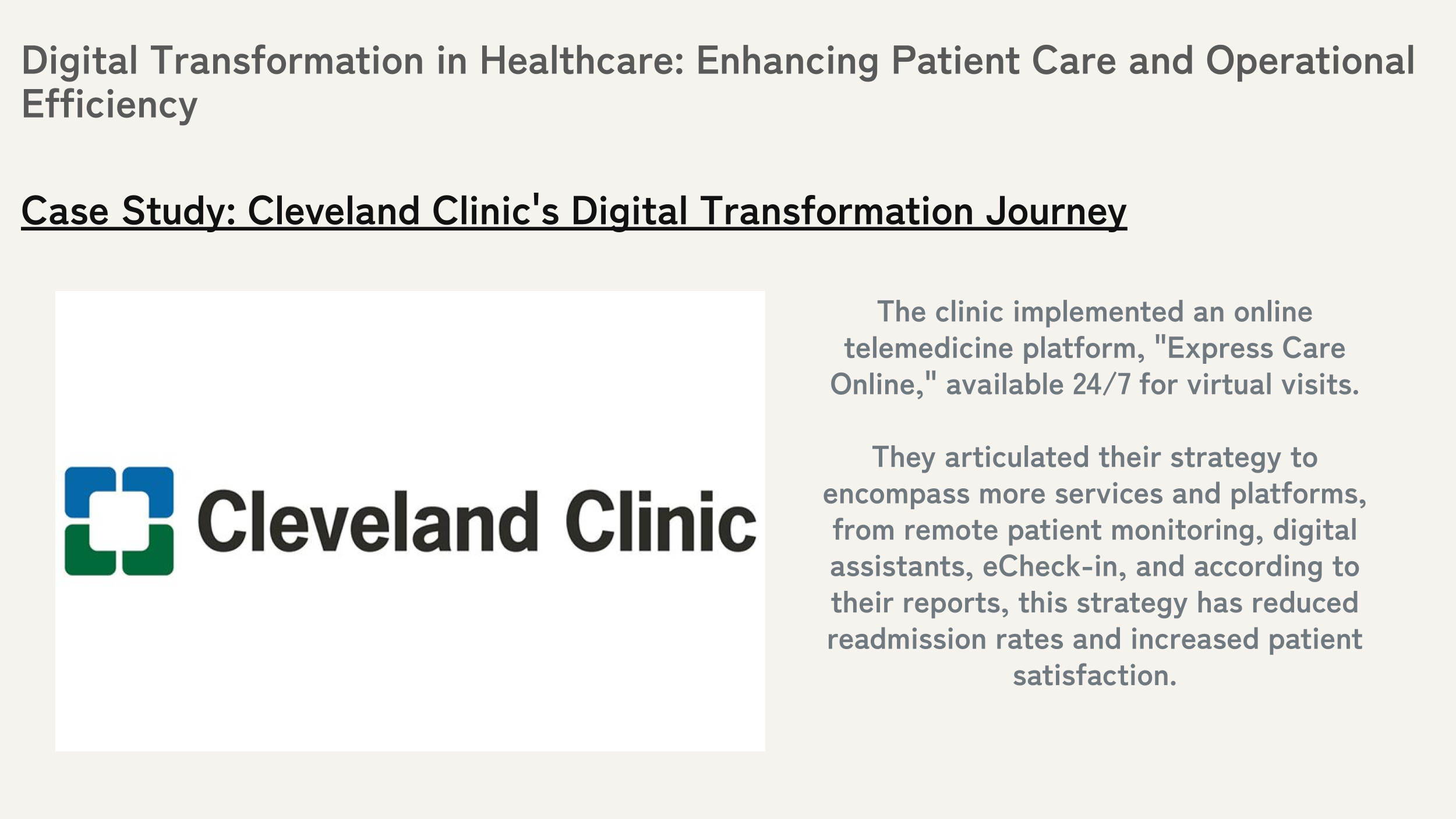Introduction
As the world continues to navigate around challenges and opportunities of the 21st century, the potential for digital technology to transform the healthcare landscape becomes increasingly evident.
Digital technologies, from artificial intelligence to IoT and advanced data analytics, have been reshaping numerous industries, and healthcare is no exception.
Digital transformation in healthcare, also known as HealthTech, has the potential to greatly improve patient care quality and operational efficiency, making healthcare more accessible, effective, and personalized than ever before.
This blog will delve into the pressing need for digital transformation in healthcare and explore how this tech-driven shift is enhancing patient care, improving delivery models, driving efficiencies, and creating sustainable, patient-centered health ecosystems.
What is Digitalization in Healthcare?
Digitalization in healthcare refers to the use of digital technologies to innovate, bolster efficiency, and transform operations within the sector.
It encompasses the transition from paper records to electronic ones, telemedicine, AI-powered diagnostics, automated patient correspondence, use of wearables for remote patient monitoring, and more.
It's the comprehensive overhaul of existing systems via digital tools to increase efficiency, reduce costs, and improve care.
The Benefits of Digital Transformation in Healthcare?
The advantages of integrating digital solutions into healthcare are profound:
- Improved Patient Experience: Digitalization brings about a personalized patient experience, faster service, better interaction with health systems, and more involvement in their healthcare process.
- Enhanced Healthcare Quality: Digital tools enable quick and real-time sharing of patient information, leading to improved decision-making and effective treatments.
- Increased Efficiency: Automating processes and digitalizing patient records increases efficiency and allows for more time to be allocated towards patient care.
- Reduced Costs: Telemedicine can reduce the need for hospital visits/feed, while predictive analytics reduce the risk of expensive emergencies.
Role of Digital Transformation in Healthcare
#1 Patient Engagement and Experience
Digital transformation initiatives prioritize patient empowerment and engagement.
Wearable devices and health apps, such as fitness trackers, heart rate monitors, and healthcare apps on smartphones, can collect patient data round-the-clock.
This helps healthcare providers gain deeper insights into patient health, improve preventive care, and aid in managing chronic conditions.
Moreover, digital tools like online booking systems and digital payment options simplify interactions with healthcare services and enhance patient experience.
#2 Real-time Health Monitoring
With IoT-enabled devices and remote monitoring tools, healthcare professionals can track the health of patients in real-time, facilitating early detection of health complications.
This is especially beneficial for remotely managing chronic conditions and post-operative care, significantly reducing unwarranted ER visits and hospital readmissions.
#3 Telemedicine
Telemedicine, fueled by advancements in video conferencing and cellular technology, has allowed patients to consult with their doctors from the comfort of their homes.
This is particularly critical in managing public health during crises, like the COVID-19 pandemic.
Telemedicine removes geographic barriers, providing access to healthcare for rural communities and patients with mobility issues.
#4 Precision Medicine
Digital transformation has paved the way for precision medicine, which personalizes treatment plans based on individual genetic, biomarker, phenotypic, or psychosocial characteristics.
Leveraging technologies like genomics and big data analytics has enabled healthcare providers to accurately predict treatment outcomes, minimize side effects, and improve patient care.
#5 Streamlined Processes
Digital technologies can streamline administrative tasks, from managing patient records to scheduling appointments and processing billing.
This reduces administrative burdens, allowing healthcare staff to focus more on patient care.
Further, predictive analytics can optimize resource allocation, improve patient flow, and enhance operational efficiency.
#6 Research and Development
AI and machine learning are revolutionizing drug discovery and development.
Virtual clinical trials utilize digital tools to collect participant data, widening the pool of potential participants, reducing costs, and speeding up the drug development timeline.
Digital Trends in the Healthcare Industry: Data-Driven Insights
The advent of technology has dramatically revamped the healthcare industry, making it more patient-centered and efficient.
Today, the lines between the healthcare and digital spheres are blurring, resulting in exciting trends that promise revolutionary healthcare advances.
Let's delve into some valuable insight of these digital trends.
1. Artificial Intelligence (AI) and Machine Learning
AI and Machine Learning have infiltrated various facets of the healthcare industry.
AI-powered predictive analysis tools enhance the early detection of diseases, result in efficient drug formulation, and improve personalized treatment plans.
One promising application of AI is in radiology, where it’s used to detect abnormalities in imaging data with high precision.
2. Telemedicine
The telemedicine market has seen significant growth, especially due to the Covid-19 pandemic.
Telemedicine improves access to healthcare especially in remote areas, reduces cost of care, and increases patient satisfaction.

3. Wearables and Internet of Things (IoT)
The IoT healthcare market is forecasted to grow to to be around US$ 111 Billion by 2027 at a CAGR of 16.43%, according to a report by Market Research Engine.
These devices collect real-time data about the patient's health, aiding in proactive and personalized care.
From tracking heart rate and sleep patterns to reminding users to stay active, these devices support preventative healthcare and promote a healthier lifestyle.

4. Blockchain
Within healthcare's complex and data-filled settings, blockchain can ensure secure and uninterrupted data flow.
It facilitates the secure exchange of patient medical records, handling of prescriptions, and management of healthcare supply chains.
Given numerous data breaches, blockchain could provide a robust solution to protect sensitive patient information.
5. Virtual Reality (VR)
While VR might seem more suited to gaming than healthcare, it has surprising and multifaceted applications in the industry.
VR can be used to train medical students, help stroke victims recover, and alleviate anxiety and pain in patients.
It's also can be used for various applications from mental health therapy, medical training, to pain management.
With ongoing research, this technology's reach within healthcare is expected to expand.
A Step-by-Step Strategy for Digital Transformation in Healthcare
To ensure a successful digital transformation, healthcare organizations must adopt a systematic and well-planned approach.
The following step-by-step strategy outlines a practical roadmap to attain digital maturity.
Step 1: Define clear objectives
Identify the specific goals and outcomes you aim to achieve through digital transformation.
Align these objectives with your organization's broader mission, prioritizing aspects such as patient care, quality improvement, and cost reduction.
Step 2: Assess current capabilities
Conduct a thorough assessment of your organization’s current infrastructure, technologies, and processes to identify strengths and weaknesses.
Gaining insight into your digital readiness will help you address potential barriers and facilitate a smooth incorporation of digital solutions.
Step 3: Map the customer journey
Understand your patients’ needs by mapping their journey from illness onset to recovery.
Identify areas where digital interventions can enhance patient experience, streamline processes, and improve outcomes.
Step 4: Leverage data and analytics
Gather, store, and analyze vast amounts of data to drive informed decisions and predict trends.
Employ smart algorithms and machine learning models to gain actionable insights, ultimately enabling personalized care and better health outcomes.
Step 5: Collaborate with stakeholders
Engage healthcare professionals and patients alike to co-create digital solutions that address their unique needs.
Involve external stakeholders, such as technology providers, to source innovative ideas, knowledge, and solutions.
Step 6: Test and deploy new technologies
Implement cutting-edge technologies, such as AI, Telemedicine, and IoT, on a small scale to gauge their effectiveness.
Make necessary adjustments based on feedback and performance before full-scale deployment.
Step 7: Scale up and integrate digital solutions
Expand the use of successful technologies throughout your organization, integrating them seamlessly with existing systems and processes.
Emphasize the importance of training and support to ensure staff are well-equipped to utilize these advancements.
Step 8: Evaluate and refine
Continuously assess the impact of implemented digital solutions on patient care, cost efficiency, and overall organization performance.
Iterate and refine strategies based on metrics and feedback, fostering a culture of continuous improvement.

Case Study: Cleveland Clinic's Digital Transformation Journey
As the healthcare sector continues to evolve rapidly, few organizations exemplify this transition as starkly as the Cleveland Clinic.
Known for its pioneering efforts to leverage technology, the Cleveland Clinic stands at the forefront of the digital transformation movement.
This section explores the Clinic's journey towards becoming a digitally mature health organization.
The Catalyst of Crisis
Digital transformation efforts at Cleveland Clinic were significantly accelerated by the arrival of the COVID-19 pandemic.
While the health crisis pushed many businesses to retreat, hospitals like the Cleveland Clinic used it as a catalyst to fast-track their embrace of digital technologies.
A pivotal advance was a new risk management algorithm enabling healthcare workers to accurately identify the severity of coronavirus cases and the necessary interventions.
This AI-enabled tool played a substantial role in a 35% reduction in hospitalizations.
To streamline patient-facing workflows and reduce administrative load, the Clinic partnered with UiPath and deployed a fleet of Robotic Process Automation (RPA) bots.
These bots hastened processes like COVID-19 testing and label printing, reducing task completion times from 2-3 minutes to 14-16 seconds.
Unleashing a Wave of Innovation
As the Cleveland Clinic navigated the pandemic, technology played a crucial role.
The crisis not only exposed the potential of these digital platforms but also fostered interest among personnel who might not have previously engaged with technology.
Experiencing the practicality and efficiency of these tools encouraged many to explore further digital applications, driving an internal culture of innovation.
Recognizing the power of telemedicine, the Clinic expanded various digital initiatives to transform patient care delivery.
Its Telehealth Express Care Service provided accessible, low-cost virtual visits, replacing more traditional treatment protocols.
Another initiative used patient-generated data from wearable devices and remote monitoring systems, enabling real-time treatment plans for proactive health management.
A Beacon for Future Healthcare
Through the case of the Cleveland Clinic, it's evident that digital transformation can revolutionize healthcare delivery and patient outcomes.
Investing in digital marketing efforts, distance health enablement, eHospital solutions, and Patient/Caregiver Apps forms a part of their strategy.
While the digital transformation journey of the Cleveland Clinic was accelerated by crisis, it cast light on the enormous potential and value of digital technologies in healthcare.
Key to their success has been a clear adoption strategy, fostering an innovation-centric culture, and harnessing the power of data for personalized and proactive patient care.
As healthcare organizations pursue their digital transformation goals, they can regard the Cleveland Clinic as a beacon.
Lessons from its journey could guide future healthcare, emphasizing the promise of technology and the vital necessity of readiness for innovation during crisis and beyond.

Conclusion
The digital transformation wave in healthcare defies the traditional norms, reshaping the sector to be more dynamic, efficient, and patient-centric.
Leveraging digital technologies offers remarkable scope to enhance patient care, streamline operations, provide personalized solutions, and increase access to health services.
As we stride further into the digital era, it becomes clear that harnessing these tech-enabled opportunities isn’t just an option, but a necessity for healthcare organizations to survive and thrive.
It's up to healthcare providers to seize this opportunity and shape the future of healthcare.
The road to digital transformation may be challenging, but it promises rewards that outweigh the hurdles.
In this digital age, healthcare providers that embrace digital transformation are the ones who will flourish.







